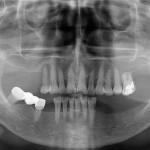
In most industrialised countries cerebrovascular accident (CVA) is a leading cause of death or permanent handicap in adults. About half of CVAs result from atherosclerotic plaques in the carotid artery and calcified carotid artery atheroma (CCAA) may be picked up early during routine panoramic radiography as an incidental finding. Angiography is the most accurate method of screening for CCAA although Doppler angiography is also an effective method but routine screening for all patients is not cost effective.
The aim of this review was to determine the diagnostic accuracy of panoramic radiography (PR) in the detection of calcified carotid artery atheroma (CCAA) in comparison to Doppler ultrasonography (DU) or angiography.
Methods
Searches were conducted in the Cochrane Library, Latin American and Caribbean Health Sciences, Medline/PubMed, Scopus, Web of Science, Google Scholar, Open Grey, and Proquest databases. Studies comparing the diagnostic accuracy of PR in detecting CCAA to Doppler ultrasonography or angiography (the reference standard) were considered. Primary outcomes were sensitivity and specificity, positive and negative predictive values, likelihood ratios and diagnostic odds ratios were secondary outcomes.
Two reviewers independently selected studies and extracted data with study quality being assessed using Quality Assessment of Diagnostic Accuracy Studies (QUADAS-2). Risk of bias was assessed as low, medium or high in 4 domains, patient selection, index test, reference standard, and flow and timing. Overall quality of evidence was assessed using the Grade of Recommendation, Assessment, Development, and Evaluation (GRADE) approach.
Results
- 12 observational studies including a total of 1002 patients were included.
- Studies were conducted in Brazil, Greece, India , Iran , Portugal, Thailand, Turkey and the USA
- Patients ages ranged from 29-71yrs.
- Prevalence of CCAA reported varied between 1.97 and 59.4%.
- 11 studies used DU as the reference test, 1 used angiography.
- 2 studies were considered to be at low risk of bias the rest were at high risk of bias.
- All 12 studies contributed to the quantitative synthesis
- Sensitivity varied from 0.31 to 0.95
- Specificity varied from 0.19 to 0.99
| All Studies
Mean (95%CI) |
Low risk studies only
Mean (95%CI) |
|
| Sensitivity | 0.732 (0.690 – 0.771) | 0.767 (0.680 – 0.841) |
| Specificity | 0.723 (0.683 – 0.761) | 0.790 (0.712 – 0.855) |
| Positive likelihood ratio | 2.319 (1.492 – 3.603) | 2.934 (1.253 – 6.867) |
| Negative Likelihood ratio | 0.396 (0.249 – 0.632) | 0.405 (0.145 – 1.133) |
| Diagnostic odds ratio | 6.923 (3.220 – 14.884) | 7.260 (1.145 – 46.046) |
The reviewers assessed the evidence as moderate to support the accuracy of panoramic radiography to screen for CCAAs using GRADE.
Conclusions
The authors concluded: –
Based on moderate level of evidence:
The diagnostic accuracy of PR in detecting CCAA was good to excellent in 50% of the studies having DU as the reference standard and poor in the study having angiography as the reference standard.
Although PR cannot be used as an initial diagnostic method when searching for CCAA, it could be used as a screening method to refer to the Doppler examination and further investigation.
Comments
This interesting diagnostic test systematic review demonstrates a degree of diagnostic accuracy for panoramic radiography in detecting CCAA. However, as the authors point out screening using Doppler ultrasonograph of large symptom-free population was shown to be cost-ineffective unless the prevalence of significant disease was ≥ 4.5%. It is worth bearing this figure in mind as effectiveness of any diagnostic test is influenced by the prevalence of the disease and the prevalence of the CCAA in this review ranged from 1.97% to 79% with all but one study having a prevalence of 19% or higher. This means that there is spectrum bias in the review which needs to be taken into consideration. While panoramic radiographs are widely used in dentistry with studies suggesting that more than 50% of dentists use PR in routine screening studies have suggested that they are of no diagnostic benefit (Dental Elf – 15th May 2012). Given the potential harms from the use of radiographs there is a need to consider the potential of identifying CCAA when a PR is necessary but currently it should not be a a reason for their use.
Links
Primary Paper
Schroder AGD, de Araujo CM, Guariza-Filho O, Flores-Mir C, de Luca Canto G, Porporatti AL. Diagnostic accuracy of panoramic radiography in the detection of calcified carotid artery atheroma: a meta-analysis. Clin Oral Investig. 2019 May;23(5):2021-2040. doi: 10.1007/s00784-019-02880-6. Epub 2019 Mar 28. Review.PubMed PMID: 30923911.
Other references
Dental Elf – 15th May 2012
No diagnostic benefit from routine screening with panoramic radiographs
